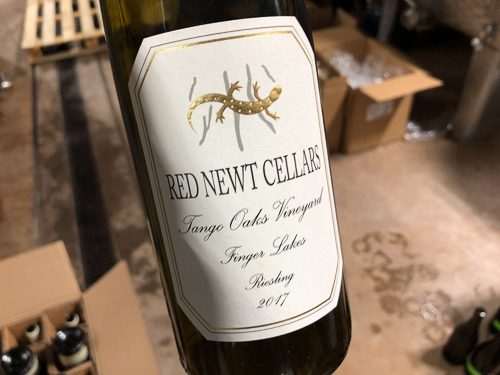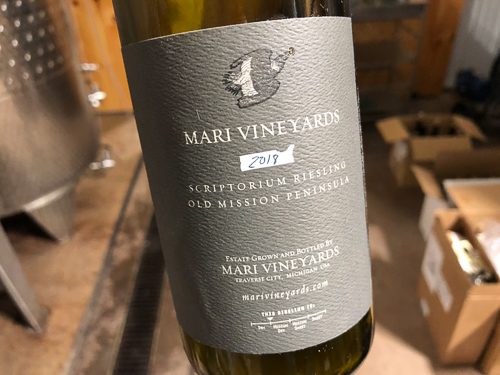
Continuing my reports from the FLXcursion in the Finger Lakes, this is a write-up of a tasting focusing on élevage: the way that winemaking can change the expression of Riesling. Typically, Riesling is fermented in tank, and stays there for 6 months to a year. But increasingly, winemakers are experimenting with vessels other than tanks, and also with extending the time on lees. We began with a wine from Forge Cellars, who were hosting the tasting, which had been aged for an extended period on lees.
Forge Cellars Seneca Lake Leidenfrost Vineyard 2017 Finger Lakes, New York State
Nicely textured with pear and apple notes alongside the sweet citrus fruit. Harmonious with nice structured and depth. Serious stuff. 93/100
Kelby Russell of Red Newt explained how he had been inspired by Ernie Loosen to keep his top wines on the lees for an extra year. Here’s the comparison of his Tango Oaks Riesling, made the normal way and also given an extra year on lees.
Red Newt Cellars Seneca Lake Tango Oaks Riesling 2017 New York State
2018 bottling. Mineral and taut with lovely citrus character. Crystalline and fine with nice weight to the concentrated fruit. Very harmonious, with lovely purity. 93/100
Red Newt Cellars Seneca Lake Tango Oaks Riesling 2017 New York State
Cask sample (old 500 litre puncheon) of the extra lees ageing wine. Linear and focused with some spice and nuts, and keen acidity and nice fine spiciness. There’s a lovely texture here with beautiful crystalline citrus fruit. Such a lovely wine. 94/100
The two wines are lovely, but extended barrel ageing has made for a wine that I find has more texture and complexity. But some people complain that the character of the Tango Oaks vineyard is undermined.

Ernie Loosen has been on a journey with extended ageing on lees in large barrels, and he talked about the first wine he produced in 1981. He had read an old winemaking book from 1817 and saw that it was common to keep wines 20-30 years in the barrel on the yeast. It sounded strange to him. So to find out what happened and whether this was really the case, he decided to learn by doing. His dad let him try this way of winemaking, and he kept this 1981 wine until 2008, 27 years in the barrel, and then bottled it. He calls it his Benjamin Button wine, because every year they taste this bottled wine it tastes younger and fresher. He had a 1947 Urziger Wurzgarten once, made this way, and was astonished how well it had matured: it wasn’t oxidized. ‘This was a winemaking style before we had technology,’ says Ernie. ‘Seitz invented the filters in the 1920s. 100 years ago they didn’t have filters or fining, so they had to keep the wine two years in the barrel for it to fine itself.’
Now Ernie is making many of his top wines using long ageing on lees in large barrels of 1000-3000 litres. They sulfur the wine after fermentation but don’t rack it. They go up to eight years in barrel. The wine is sulfured at the end of the fermentation (to discourange malolactic), and then it’s topped up every four weeks. He doesn’t like malolactic in Riesling: it’s an aromatic grape, so why lose that character? ‘It is a tool to give these wines ageability,’ he says. ‘It is not a good business model.’
We compared two wines, made from the same juice, aged 12 months and 36 months in barrel. Both were fantastic, but there was something else to the wine aged three years.
Dr Loosen Urziger Wurzgarten Riesling Grosses Gewachs 2012 Mosel, Germany
Powerful, spicy, lovely acidity, has lime and lemon with some pear notes. Has great texture with crystalline citrus fruit and a slight spicy twist. This is pretty serious, with a long finish. 95/100
Dr Loosen Urziger Wurzgarten Riesling Hommage 2012 Mosel, Germany
This will be aged for seven years before release. It’s 36 months at the moment. It’s taut, mineral, spicy and linear with a lemony edge. Very detailed and delicate showing a slight herby edge to the linear citrus fruit. Complex and beguiling. 95/100
We also looked at the effect of different vessels on wine. First, a comparison of the same wine fermented and aged in cement egg and older barrels, made by Ovum wines from Oregon.
This is from most southern vineyard in the state of Oregon. It was a creek bed 30 years ago, and it has a lot of serpentine in the soil, at 1500 ft elevation. Harvested October 22 at 22 Brix. 7.7 TA, 2.9 pH. Half is destemmed, pressed to egg and barrel.
‘If the site expresses minerality, the egg will jack the minerality up and it often steals fruit,’ says winemaker John House.
Ovum Off The Grid Riesling 2018 Rogue Valley, Oregon
(Cement egg sample). Cloudy with some sweet appley fruit. Still a bit of sweetness with a nice mineral core. A bit oxidative, but will probably clean up when fermentation is finished and sulfur is added. 90/100
Ovum Off The Grid Riesling 2018 Rogue Valley, Oregon
(Older barrel sample). Clear. Has a nice stony, citrus character. Has a lovely mineral core with a fine spiciness. 92/100

Mari, a winery in Michigan, showed the same wine, aged in large oak barrels (known as stücks and dopplestücks in Germany. Winemaker Sean O’Keefe explained how they built a new winery in 2016 bought and bought four dopplestücks (2400 litres) and two stücks (1200 litres). These aren’t ready to use immediately for the top wines: they take four of five years to be ready once they have stopped contributing wood character. This was a comparison between the stück and the tank.
Mari Vineyards Jamieson Vineyard Riesling 2018 Old Mission Peninsula, Michigan
Stück. Linear and bright with nice texture and some spice. Crystalline citrus fruits with a nice spicy mouthfeel. Dry style. Lots of interest, and just a hint of wood. 91/100
Mari Vineyards Jamieson Vineyard Riesling 2018 Old Mission Peninsula, Michigan
Tank. Bright and lively with nice citrus fruit, and a bit of apple character. Juicy with a hint of honey. Very lively and fruity. Pretty. 89/100

Next up was a blind tasting of the same wine fermented in wood (fuder), steel, and stone (granite cylinder). My guesses are in brackets, and the answer comes after.
Weingut Schmitges Erdener Treppchen Riesling Trocken 2016 Mosel, Germany
1 Spicy and citrussy with nice precision. Has a really nice mouthfeel with a crystalline quality. Lovely wine. 94/100 (fuder?) steel
2 Bright and lively with lovely precision. Fresh citrus fruit with nice brightness to the citrus fruit, with detail and focus. 94/100 (granite?) stone
3 Lively, precise, bright, linear and citrussy with lovely intensity. Such precision here. Very lemony with bright acidity. 92/100 (steel?) wood
Last, a comparison of stainless steel versus glazed earthenware.
Lesehof Stagard Steiner Hund Riesling 2015 Kremstal, Austria
Stainless steel. Crystalline and intense with nice citrus drive. There’s some bright spiciness here with some depth and stoniness. Nice intensity. 93/100
Lesehof Stagard Steinzeug Riesling 2015 Kremstal, Austria
750 litre glazed earthenware. This has a touch of honey and a rounded texture, with a mineral edge to the apple and pear fruit. Very rounded. 92/100
Find these wines with wine-searcher.com
FLXcursion
2 Comments on FLXcursion International Riesling Expo (2) Contact track
I am sure you are aware of one of the grandaddy’s of this philosophy the Nikolhaiof Vinothek Austrian riesling that is kept for 20 years or so in tank.. the gold standard from my perspective.
The wine is sulfured at the end of the fermentation (to discourange malolactic), and then it’s topped up every four weeks.
Are you not going to end up with vast s02 total levels over 8 years of doing this?
Either way it sounds to die for.. I presume it won’t be on public release though?